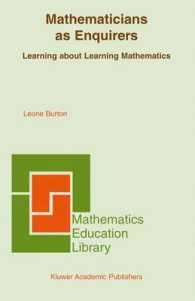Full Description
IMÁGENES, Third Edition, takes a functional, integrated skills approach specifically designed to help students develop receptive and productive skills simultaneously that are critical in learning Spanish. When using IMÁGENES students acquire communicative skills while gaining an awareness of Hispanic cultures. The program's practical, relevant themes, lively practice, and engaging technology components get learners communicating early and confidently. The exciting new third edition will contain a greater focus on the cultures of Spanish-speaking countries and have two new video blogs in each chapter to provide input of chapter functions and vocabulary. IMÁGENES will keep students motivated as they learn and explore the many cultures of Spanish-speaking world.
Contents
CAPÍTULO PRELIMINAR: BIENVENIDOS AL MUNDO HISPANO Las presentaciones. Los saludos y las despedidas. Países de habla española y sus capitales. Expresiones para la clase. Deletreo y pronunciación de palabras: El alfabeto. Acentuación (Stress). Cultura: Countries with most Spanish-speakers; Tú vs. usted ; Use of adiós ; The abrazo and beso; Spanish-speaking countries and capitals; Spanish in the world; Facts about the Spanish alphabet. How to read acronyms.
CAPÍTULO 1. ¿QUIÉN ES? (HISPANOS EN LOS ESTADOS UNIDOS). Para ver I. Mi video blog número 1. Vocabulario esencial I. Los números del cero al cien: II. Las nacionalidades: Gramática para la comunicación I. Talking About Yourself and Others (Part I): Subject Pronouns. Asking and Giving One's Name: Llamarse. Stating Origin: Ser + de, ser + nationality. Indicating One's Age: Tener. Nuevos horizontes. Reading Strategy: Scanning. Lectura: "Los hispanos en los Estados Unidos". Vocabulario esencial II. Las ocupaciones: Discussing occupations. Para ver II. Mis padres y amigos. Gramática para la comunicación II. Talking About Yourself and Others (Part II): Subject Pronouns in the Singular and Plural. The Verbs llamarse, tener, and ser. Plural Forms of Occupations and Adjectives of Nationality. Asking Information and Negating: Question formation; Negating. Más allá. Canción: "La bamba", Los lobos. Video: El mes de la herencia hispana. Cultura. Points of interest in Chicago and Los Angeles on Para ver I video; Two last names on Para ver I video; Reading telephone numbers; Referring to people from the U.S.; Hispanics vs. Latino in the U.S.; Demographics of Hispanics in the U.S.; Origin of Hispanics in the U.S.; Spanish words used in English and English words used in Spanish; Diversity of Hispanics; Famous Hispanics. Material reciclado. Introductions (P); Country names (P); Llamarse (P); Ser de + place (P); Tú vs. Ud. (P); Alphabet (P); Geography (P).?
CAPÍTULO 2. ¿TE GUSTA? (CUBA, PUERTO RICO, LA REPÚBLICA DOMINICANA Y PANAMÁ). Para ver I. Una visita a Puerto Rico. Vocabulario esencial I. La habitación de un estudiante universitario. Gramática para la comunicación I. Using Gender and Number: Gender. Plural Formation. Expressing Likes and Dislikes (Part I): Gustar. Expressing Possession: The Preposition de; Possessive Adjectives. Nuevos horizontes. Reading Strategy: Identifying Cognates. Lectura: "Facultad de Ciencias de la Computación". Writing Strategy: Connecting Ideas. Vocabulario esencial II. Acciones. Los días de la semana. Para ver II. Planes para la República Dominicana y Panamá. Gramática para la comunicación II. Expressing Likes and Dislikes (Part II): Gustar. Expressing Obligation: Tener que. Making Plans: ir a. Más allá. Canciones: "¡Vive!", "Estrellitas y duendes" y "Merengue con letra". Video: La ruta del carnaval dominicano. Cultura. Cuba, the Dominican Republic, Puerto Rico, and Panama throughout the chapter and on the Para ver I and II videos; History of Puerto Rico; Where college students live; Baseball; University systems including the facultad; Kunas and Tainos; Merengue, bachata, bolero, salsa, hip-hop, and reguetón; Carnaval de las Tablas; Carnaval in the Dominican Republic. Material reciclado. Tener (1); Ser (1); Question formation (1); Negation (1).?Geography (P).
CAPÍTULO 3. ¿QUÉ HACES HOY? (COSTA RICA Y NICARAGUA). Para ver I. Una entrevista en Playa Jacó. Vocabulario esencial I. Lugares. Gramática para la comunicación I. Indicating Location: Estar + en + place. Talking About the Present (Part I): The Present Indicative of Regular Verbs. Talking About the Present (Part II): The Present Indicative of Verbs with Irregular yo Forms. Nuevos horizontes. Reading Strategy: Dealing with Unfamiliar Words. Lectura: "¿Qué hacer este fin de semana en San José?" Writing Strategy: Using Models. Vocabulario esencial II. El físico y la personalidad: Ser + Adjective. Las emociones y los estados: Estar + Adjective. Para ver II. Hay familias... y... FAMILIAS. Gramática para la comunicac








